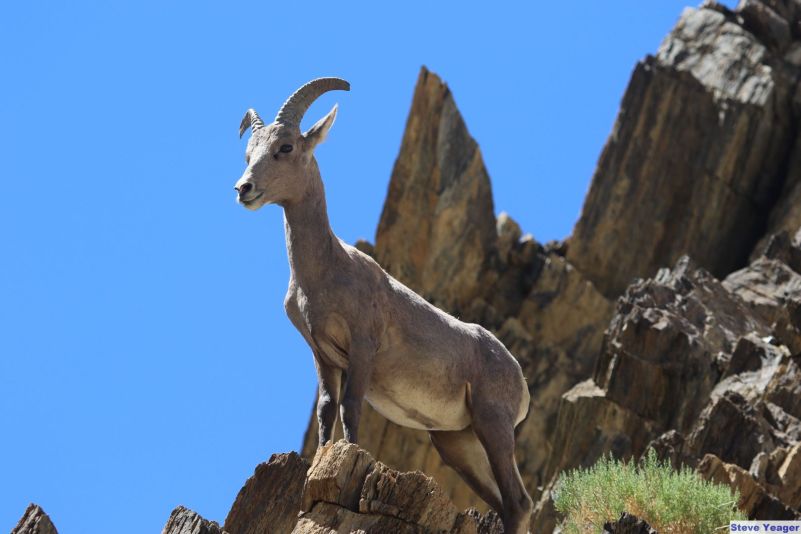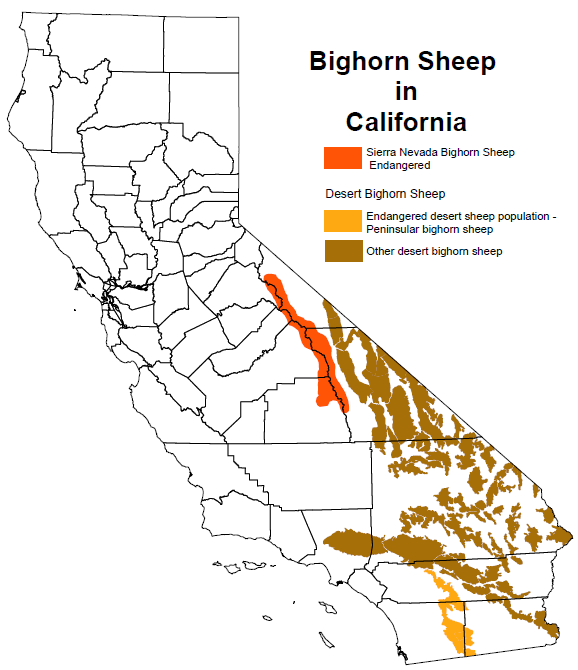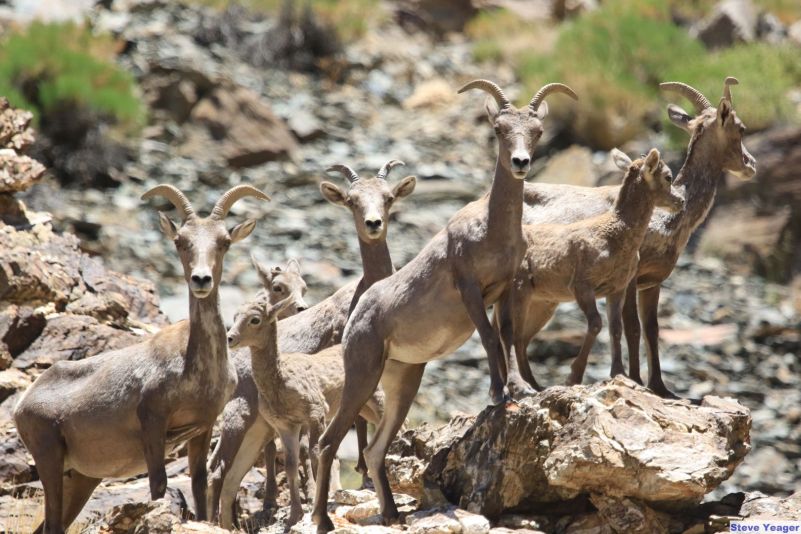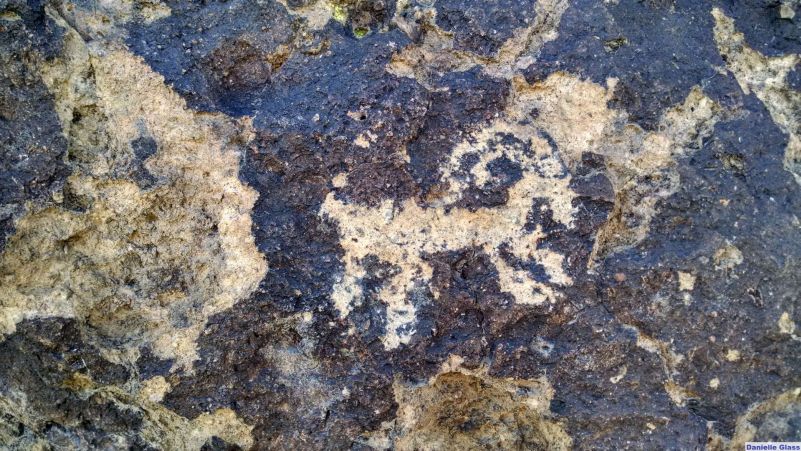Basic Facts
 A desert bighorn ewe surveys her surroundings. Photo © Steve Yeager.
A desert bighorn ewe surveys her surroundings. Photo © Steve Yeager.
Named for their large horns, bighorn sheep (Ovis canadensis) are hoofed ruminants of the family Bovidae. Desert bighorn sheep (Ovis canadensis nelsoni) are a subspecies that is adapted to the desert regions of California, Nevada, Arizona, New Mexico, Utah, Colorado, Texas, and Baja California. Desert bighorn have brown or grey hair, with white patches on their rumps and muzzles. Rams (male bighorn) weigh 120-220 pounds, while ewes (female bighorn) weigh 100-155 pounds. Both rams and ewes grow horns, though rams’ horns grow significantly larger than ewes’ horns. Rams generally live for up to 12 years, while ewes live up to 20 years.
Range and Habitat
 Range of Bighorn Sheep in California. PDF version of map.
Range of Bighorn Sheep in California. PDF version of map.
 Three adult ewes, 1 yearling ewe, and 3 lambs. Photo by Steve Yeager.
Three adult ewes, 1 yearling ewe, and 3 lambs. Photo by Steve Yeager.
California’s desert bighorn range from the White Mountains in the north to the Mexican border in the south. They prefer ‘escape terrain’ - steep, rocky, open landscapes with good visibility and easy predator detection. Desert bighorn survive in temperatures over 120°F in the summer. The White Mountain population of desert bighorn is unique in California, living at up to 14,000 ft and in snowy conditions in the winter months. Learn more about desert bighorn ecological niche, habitat selection, habitat variation and surface water use in California.
Life History
For much of the year, ewes and rams are segregated. Given their need to protect and care for lambs, ewes stay in relatively mountainous terrain where they are safer from predation. Ewes may group together for additional protection. Rams disperse longer distances in milder terrain that is more accessible to predators. They can make movements of up to 75 miles. During the mating season, or rut, rams will join with ewe groups and try to mate with as many ewes as possible. Bighorn sheep follow a polygynous mating strategy whereby the dominant males do most of the breeding.
Desert bighorn sheep have a six-month gestation period with most ewes giving birth to one lamb per year; twins are rare. Without the constraint of severe winters in most of the desert, lambing can occur from mid-December through mid-June. The peak of lambing is usually from February through March, but lambing seasons vary significantly across mountain ranges. Lambs are very mobile within a few days of birth, and are typically weaned by five months of age. Lamb survival varies greatly in the desert, depending on rainfall, forage growth, and disease status within a population. If nutrition is adequate, ewes first breed when they are 1 year old. Males reach sexual maturity at the same age, but are not able to establish dominance until they are older (often five or older). Learn more about desert bighorn life history.
Diet and Nutrition
Desert bighorn sheep are ruminant herbivores that are adapted to digest a variety of forage species. They are selective feeders that choose the most nutritious forage available. Their diet includes cacti, grasses, herbaceous plants, shrubs, and a few trees. Barrel cacti (Genera: Echinocactus and Ferocactus) and catclaw acacia (Senegalia greggii) are especially important forage for desert bighorn in the Mojave Desert, especially during the hot summer months. In times with adequate precipitation, desert bighorn can stay hydrated from forage alone. During hotter periods, desert bighorn visit springs or other surface water sources on average once every 3-7 days. Learn more about desert bighorn nutrition in California.
Behavior
Bighorn sheep are gregarious, typically forming herds. Within these herds, they continuously interact with each other and are known to mimic the behavior of other members of the herd. Lambs play and can often be seen chasing each other throughout the group. Body posture and scent are part of social communication. Bighorn sheep rarely vocalize, but do sometimes bleat when seeking another animal (for example, a ewe seeking her lamb). They may make a coughing sound when alarmed.
Bighorn sheep possess dominance hierarchies, one among ewes and another among rams. Status among both ewes and rams can be determined by horn size relative to other members of their sex. Dominant ewes determine herd movement, while dominant rams mate with more ewes. To determine dominance, rams head-butt and clash horns. Further ram interactions include displacement from a bedding site, kicking, butting, and neck-wrestling. Learn more about bighorn behavior.
Native American Culture
 A bighorn sheep petroglyph in the Mojave National Preserve, California. CDFW photo by Danielle Glass.
A bighorn sheep petroglyph in the Mojave National Preserve, California. CDFW photo by Danielle Glass.
Throughout the range of California’s bighorn sheep, there are rock engravings of bighorn sheep. Using radiocarbon dating, archaeologists believe that these petroglyphs are between 1,000 and 16,000 years old. Archaeologists also believe that these petroglyphs were engraved by the ancestors of the Mojave, Shoshone, and Paiute people. Bighorn sheep are still valued by these tribes today.
Learn more about the history and taxonomy of bighorn sheep in California, and current population status.